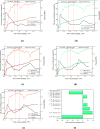Experimental Study of Synergy between Polymeric Microspheres and Nanoemulsions for Profile Control and Water Plugging
- PMID: 39494023
- PMCID: PMC11525518
- DOI: 10.1021/acsomega.4c06346
Experimental Study of Synergy between Polymeric Microspheres and Nanoemulsions for Profile Control and Water Plugging
Abstract
The development of low-porosity and low-permeability oil reservoirs in the Changqing oilfield presents a significant challenge due to the high injection pressure and limited space for profile control and pressure raising. Therefore, the synergistic profile control and flooding technology of polymer microspheres (PMs) and nanoemulsions is proposed, which makes use of the plugging performance of PMs and the pressure-reducing and oil-driving properties of nanoemulsions, with the objective of controlling the water-absorbing profile and increasing the recovery rate. The paper assessed the properties of nanoemulsions and PMs and evaluated their suitability for reservoirs. The construction parameters of profile control and flooding were optimized on an experimental basis. The experimental results demonstrate that the initial particle size of microspheres can more closely match the pore diameter of the formation and that the core exhibits a higher plugging rate after hydration and expansion. Moreover, the nanoemulsion can effectively reduce the interfacial tension, thereby exerting a beneficial effect on pressure reduction. The construction parameters of microspheres and nanoemulsions were optimized by alternately injecting them with 2:1 multistage plugs, and the injected pressure was lowered by 43%, with a high plugging rate and value-added recovery rate of up to 26.5%. Based on the experimental study, 8 well sets of field tests were conducted, and the results demonstrated that the efficiency rate of profile control reached 50%. Furthermore, the average injection pressure of the injected wells decreased by 1.7 MPa, the rise in water content decreased by 2.27%, and the petroleum production increased by 1110.2 tons. The validity period reached 162 days, indicating a positive application effect.
© 2024 The Authors. Published by American Chemical Society.
Conflict of interest statement
The authors declare no competing financial interest.
Figures










Similar articles
-
Investigation on Plugging and Profile Control of Polymer Microspheres as a Displacement Fluid in Enhanced Oil Recovery.Polymers (Basel). 2019 Dec 2;11(12):1993. doi: 10.3390/polym11121993. Polymers (Basel). 2019. PMID: 31810357 Free PMC article.
-
Enhanced Oil Recovery Mechanism and Technical Boundary of Gel Foam Profile Control System for Heterogeneous Reservoirs in Changqing.Gels. 2022 Jun 12;8(6):371. doi: 10.3390/gels8060371. Gels. 2022. PMID: 35735715 Free PMC article.
-
Numerical Simulation of the Microscopic Plugging Mechanism and Particle Flow Process of the Microsphere System.ACS Omega. 2022 Dec 5;7(50):46983-46991. doi: 10.1021/acsomega.2c06088. eCollection 2022 Dec 20. ACS Omega. 2022. PMID: 36570272 Free PMC article.
-
Recent Advances in Polymer Flooding in China.Molecules. 2022 Oct 17;27(20):6978. doi: 10.3390/molecules27206978. Molecules. 2022. PMID: 36296573 Free PMC article. Review.
-
Advances of polymer microspheres and its applications for enhanced oil recovery.Colloids Surf B Biointerfaces. 2024 Jan;233:113622. doi: 10.1016/j.colsurfb.2023.113622. Epub 2023 Oct 28. Colloids Surf B Biointerfaces. 2024. PMID: 37931531 Review.
References
-
- Sang Q.; Li Y.; Yu L.; Li Z.; Dong M. Enhanced oil recovery by branched-preformed particle gel injection in parallel-sandpack models. Fuel 2014, 136, 295–306. 10.1016/j.fuel.2014.07.065. - DOI
-
- Zhang P.; Lu S.; Li J.; Xue H.; Li W.; Zhang P. Characterization of shale pore system: A case study of Paleogene Xin’gouzui Formation in the Jianghan basin, China. Mar. Petrol. Geol. 2017, 79, 321–334. 10.1016/j.marpetgeo.2016.10.014. - DOI
-
- Yuan Y.; Rezaee R. Comparative Porosity and Pore Structure Assessment in Shales: Measurement Techniques, Influencing Factors and Implications for Reservoir Characterization. Energies 2019, 12 (11), 2094.10.3390/en12112094. - DOI
-
- Zhou R.; Zhang D.; Wei J. Experiment on the profile control effect of different strength gel systems in heterogeneous reservoir. Energy Rep. 2021, 7, 6023–6030. 10.1016/j.egyr.2021.09.060. - DOI
-
- Ding B.; Dong M.; Chen Z.; Kantzas A. Enhanced oil recovery by emulsion injection in heterogeneous heavy oil reservoirs: Experiments, modeling and reservoir simulation. J. Pet. Sci. Eng. 2022, 209, 109882.10.1016/j.petrol.2021.109882. - DOI
LinkOut - more resources
Full Text Sources
